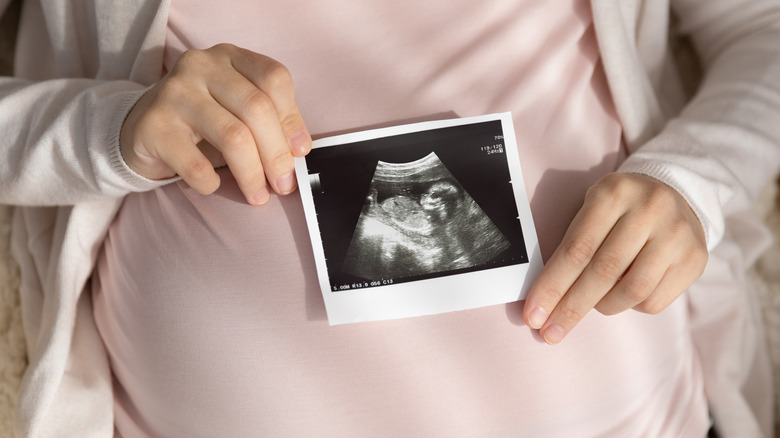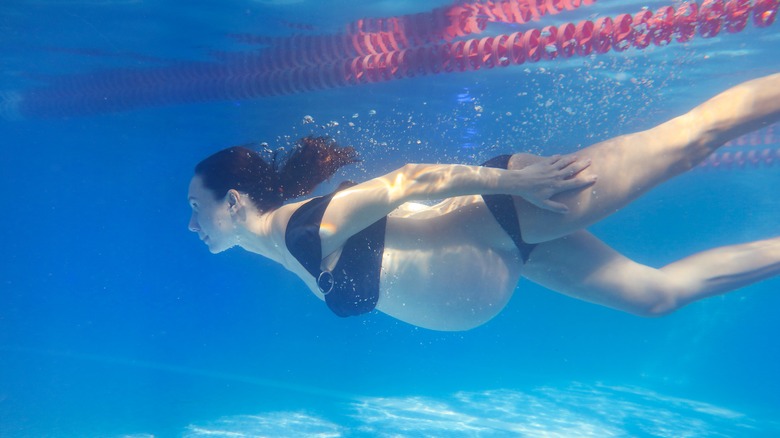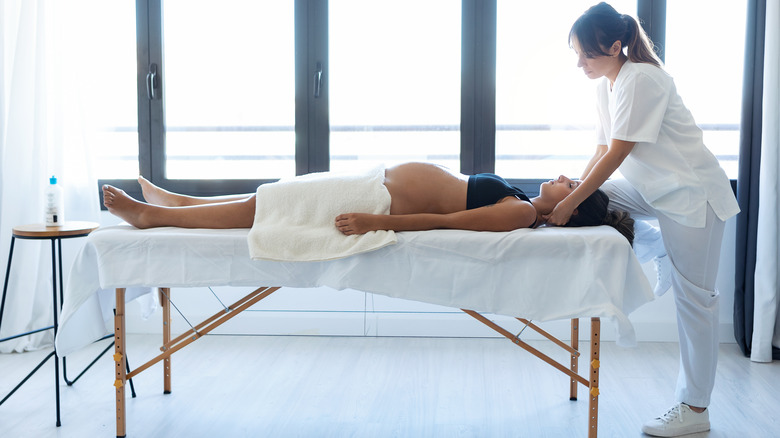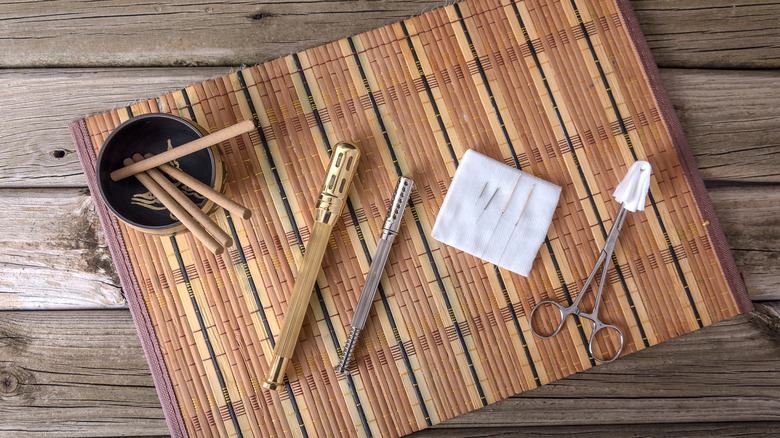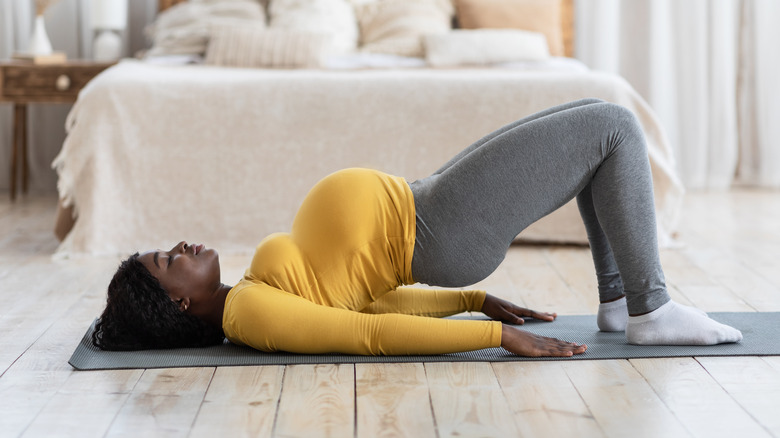Ways To Turn A Breech Baby Before Labor
In the weeks prior to giving birth, a baby will turn within the uterus to have its head positioned downward against the cervix, which is the optimal position for safe vaginal delivery, as per the Cleveland Clinic. In some cases, however, this doesn't happen and the baby's head remains pointed upward, underneath the ribcage, with their feet or backside pressed up against the cervix. This latter position is known as breech and happens in around 3% to 4% of pregnancies.
The American College of Obstetricians and Gynecologists (ACOG) explains that a baby in the breech position can lead to potentially serious complications, including placental abruption, which is a condition when the placenta detaches too early from the uterus and interferes with the baby's ability to receive oxygen and nutrients (via Mayo Clinic). If vaginal birth is attempted while the baby is in the breech position, other complications can occur, such as the head and shoulders getting stuck or a prolapsed umbilical cord, which prevents oxygen from reaching the baby until they are able to use its lungs (per ACOG). To prevent these risks, many breech babies are delivered via cesarean section.
The NHS points out that prior to labor, it is possible to attempt to turn the baby while they are still in utero in order to achieve a safe vaginal birth. While the most common method is known as the external cephalic version (ECV), there are other ways this can be accomplished.
External cephalic version (ECV)
The most common method for turning a baby from the breech position into the cephalic (head first) position is known as the external cephalic version (ECV) and involves a practitioner manually attempting to shift the baby from the outside, as explained by WebMD. This procedure is usually guided by ultrasound and accompanied by IV medications designed to loosen up the uterus. Then, the doctor will place their hands on the belly and apply pressure to flip the baby. Given the challenge of doing this from the outside, the procedure can take multiple hours and even then, only proves successful in around 50% of cases.
Luckily, there are ways to improve the outcomes of an ECV procedure, including carrying it out before 36 weeks gestation when the baby still hasn't grown too large. It also helps if there is an adequate cushion of amniotic fluid surrounding the baby to give them room to flip. In situations where the doctor can't find the baby's head or discovers that the uterus is too rigid to manipulate properly, the procedure will be less likely to work.
Before giving the go-ahead for an ECV, it's also important to understand the risks. The NHS points out that in some cases, the physical maneuver can cause bleeding within the placenta, which can prove harmful to the baby and lead to an emergency cesarean section. That being said, some pain and discomfort following the procedure is normal.
Swimming
A less hands-on approach to flipping a breech baby is an activity that may even be enjoyable to the pregnant individual: swimming. Better Birth Blog explains that certain activities in the water are more likely to aid in the turning of a breech baby, including diving to the bottom and performing handstands. The buoyancy, coupled with the water pressure, can encourage the baby to turn on its own.
The Corpus Christi Birth Center also recommends water immersion to help turn a breech baby. The water should be set around 72 degrees Fahrenheit to help relax the muscles surrounding the baby, increasing the space in which they have to move. Before diving into the deep end of the pool, experts encourage lifting the belly upon entry into the water and then letting go once you are fully immersed. You should, then, perform several dives, making sure to go as deep as the pool allows.
Using water immersion to turn a breech baby was also tested in a 2019 Russian study that looked at the efficacy of a water aerobics class on a sample of 100 participants. After several exercise sessions, researchers recorded that 83 were able to successfully flip their babies. And about 67% of those 83 participants found that their babies turned on their own after just two to three sessions, making water immersion and activity a promising avenue for correcting breech positioning.
The Webster Technique
Another way to turn breech babies was developed in the 1980s by chiropractor Dr. Larry Webster, which is aptly known as the Webster Technique, as per the International Chiropractic Pediatric Association. The method targets the pelvic area and is designed to make more room for the baby to flip to the headfirst position by addressing musculoskeletal issues that lead to constraints of the uterus.
Healthline explains that the Webster Technique requires the pregnant individual to lie face down on a table — since the extended belly complicates this position, most chiropractors offer a specially designed pillow or table to make it more comfortable. The next step is to determine whether the pelvis is suffering from a misalignment, which can make the baby's flip into the headfirst position more difficult. This is carried out by bending the feet up toward the backside and seeing whether one side extends further than the other. If this happens, the practitioner will need to realign the pelvis with a specialized adjustment procedure. They will also perform a massage of the ligaments and muscles surrounding the uterus and pelvic area on the front of the body with the intention of opening up more space for the baby.
One 2002 scientific study examined the efficacy of the Webster Technique and found that the success rate was as high as 82% after surveying over 1,000 chiropractors in the United States and Canada. It was also most successful when carried out in month eight of pregnancy.
Moxibustion
Moxibustion is a type of traditional Chinese medicine that incorporates the leaves of the mugwort plant (per WebMD). Practitioners typically burn the leaves near the surface of the skin, which is believed to help with blood strengthening and the flow of energy within the body. In addition to being used to treat digestive issues and generalized pain, moxibustion has also proven promising for encouraging a breech baby to flip to the headfirst position.
It is believed that the burning of the mugwort leaves at a specific location of the body provokes the production of pregnancy hormones, such as prostaglandin and estrogen, which may lead to slight contractions of the uterus and encourage the baby to turn around, as per a 2021 systematic review of studies examining the practice. Another 2019 systematic review of studies evaluating the effectiveness of this technique found that moxibustion had statistically significant success when it came to turning breech babies, although it acknowledged that further research is necessary for the area.
UNM Health adhipvises beginning nightly sessions of moxibustion at around 34 weeks gestation. Using pre-rolled moxi sticks, you'll burn them near your smallest toes, attempting to get as close as possible to the skin without harming yourself. You can use books or other props to hold the sticks in place underneath your feet, and each session should last around 20 minutes. If you don't want to go the DIY route, you can also find a moxibustion practitioner in your area for professional sessions.
Pelvic exercises
If your baby is proving to be stubborn in its breech position, it may be beneficial to try out some at-home pelvic exercises. Although the Cleveland Clinic points out that there is a lack of scientific evidence to back up this method, some recommendations include the bridge position and the child's pose.
The bridge position is carried out while lying on your back on the floor. With your knees bent, you will want to lift your hips up so that your backside is also hovering in the air. You should try to sustain this position for at least 10 minutes and repeat the entire exercise multiple times a day.
The child's pose, on the other hand, is used to stretch and relax the muscles around the hips and pelvic area, according to the Mayo Clinic. Luckily, the publication provides an instructional video on how to carry out the pose, which involves kneeling on a yoga mat or other soft surface and bending forward so your upper body is stretched out in front of you and your forehead is resting on the floor. Your knees should be spread slightly open so that your belly has room to rest between your legs. Some gentle movement in this position can help open up space in the pelvis as well. Once again, aim to hold this pose for about 10 minutes, ideally more than once a day (via the Cleveland Clinic).

